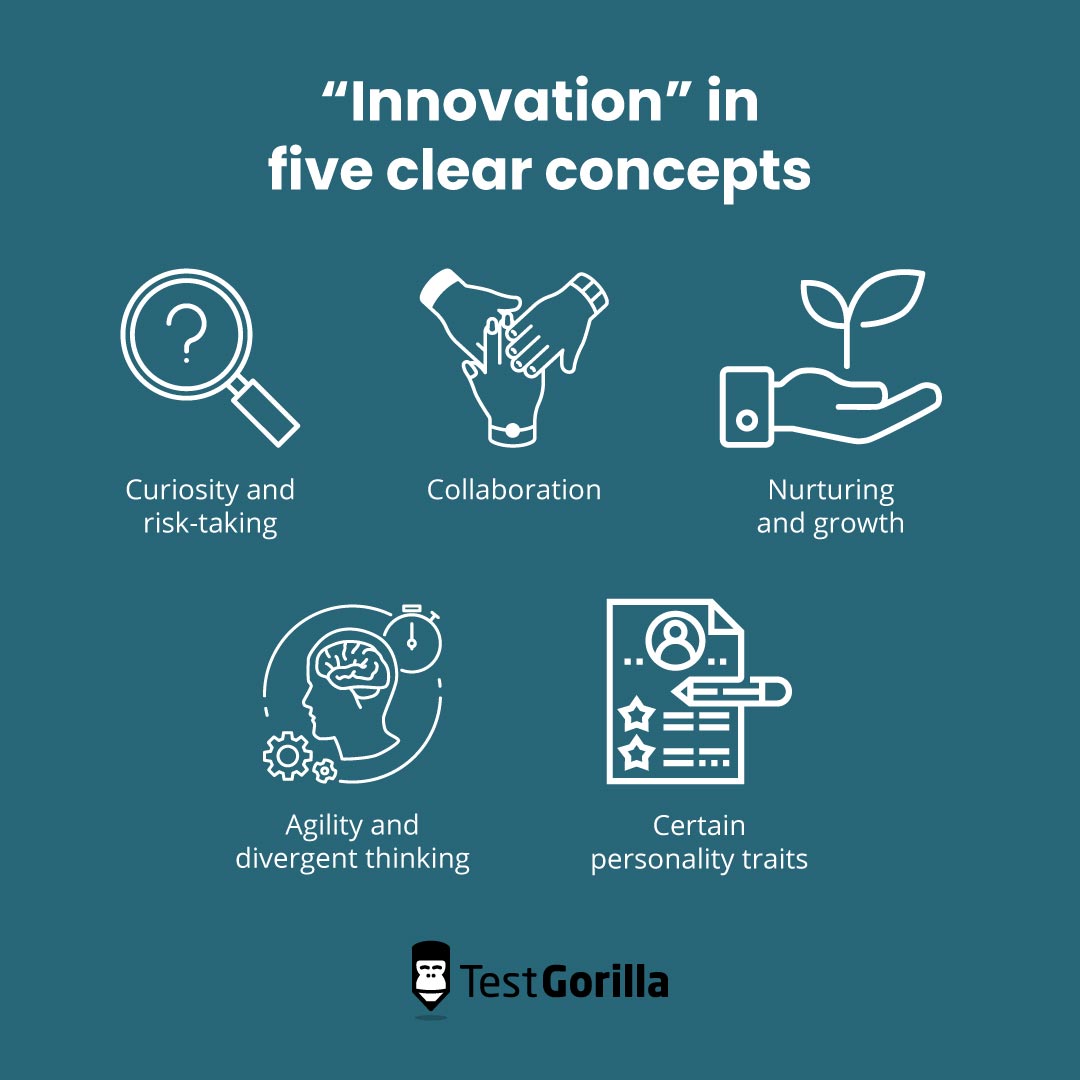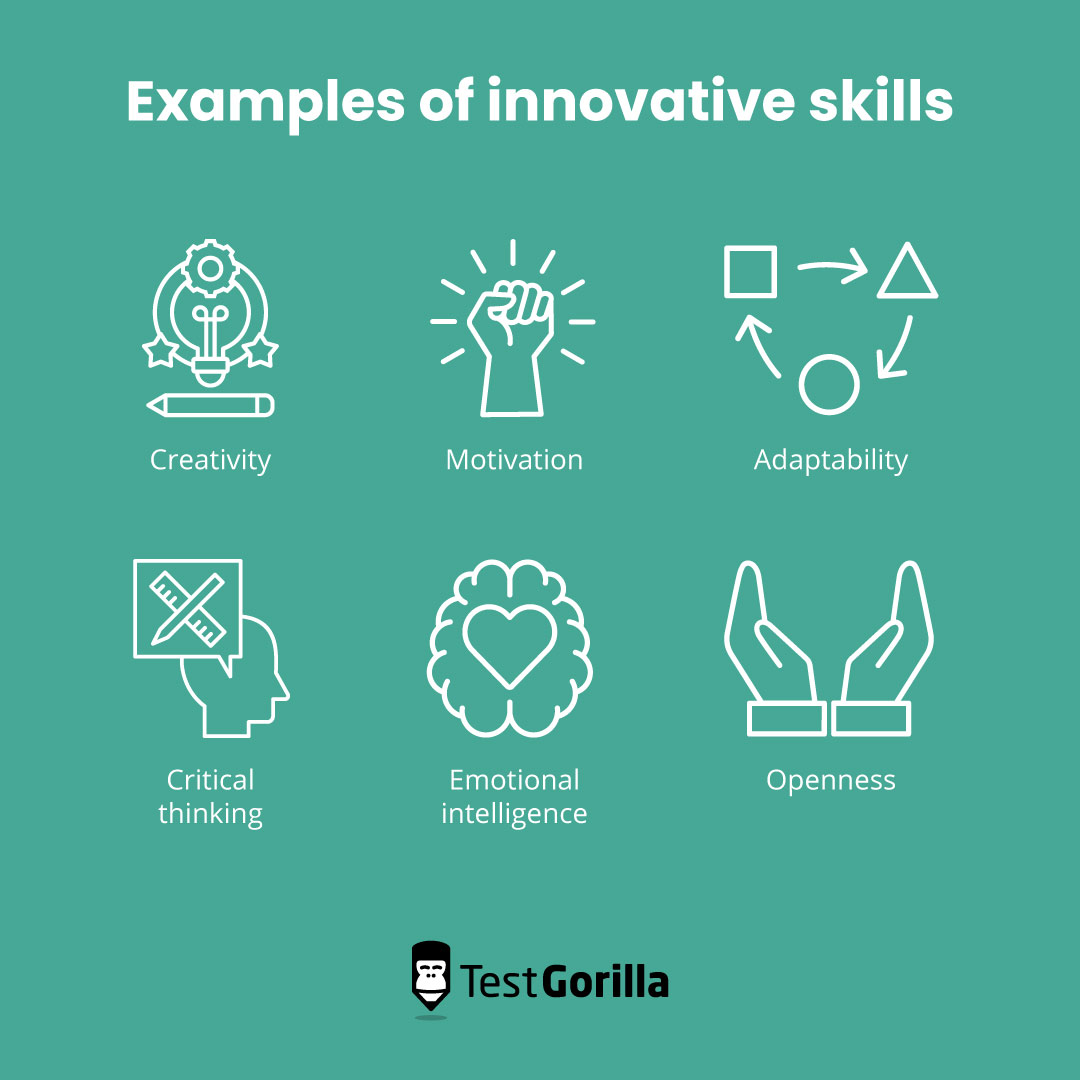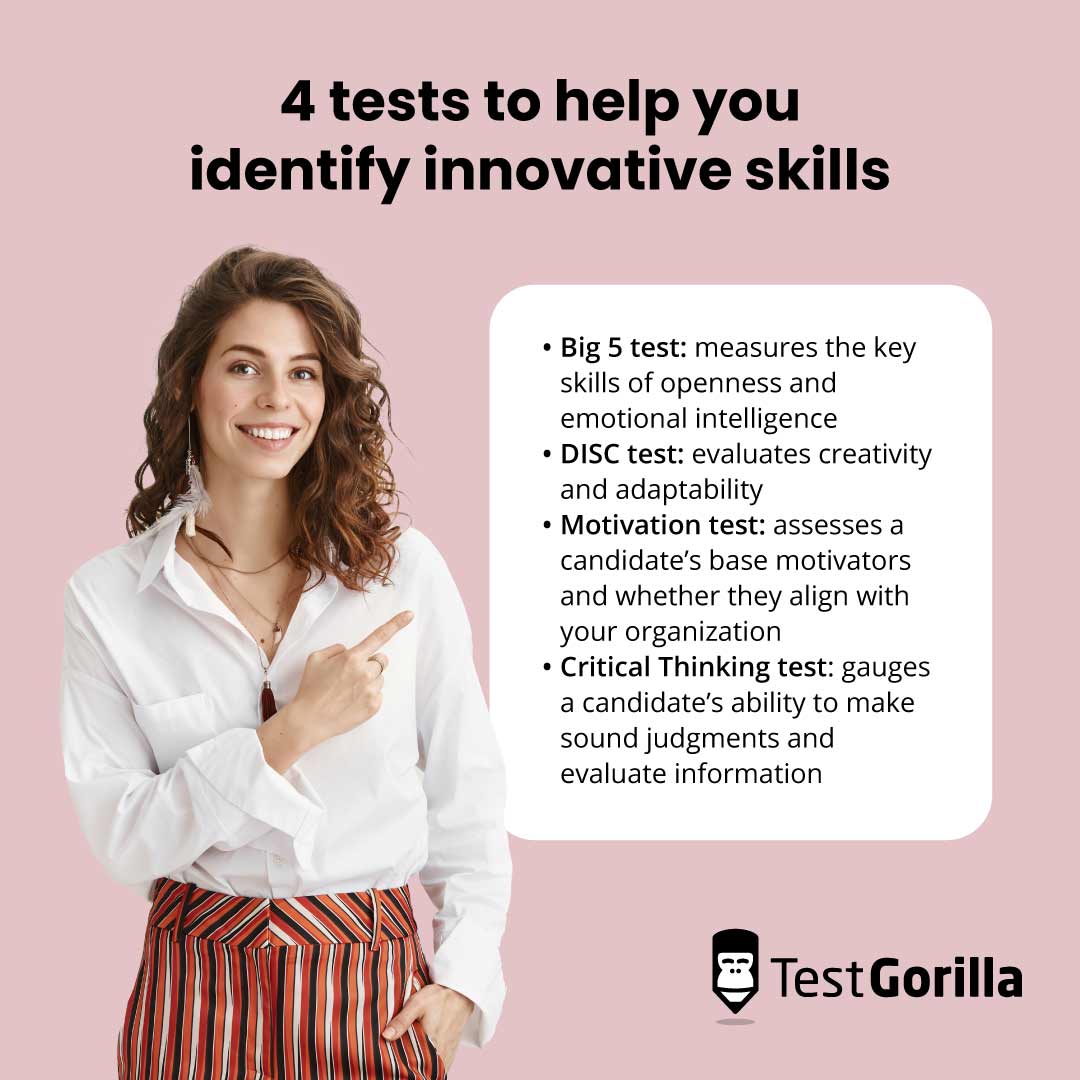Does skills-based hiring have an impact on innovation and innovative thinking?
Innovation drives organizations forward, leading to better discoveries and improved financial performance.
It’s a core priority, and every business is looking for ways to nurture it.
But “innovation” isn’t exactly a measurable metric like turnover or retention. As important as it is, companies struggle to nail down concrete ways to boost innovation.
What does innovation look like in a skills-based organization? Does skills-based hiring have an impact on innovative thinking?
We might have cracked the code on this abstract concept.
Skills-based practices naturally cultivate many of the foundations of great innovation, such as psychological safety, a healthy company culture, and a diverse range of perspectives.
Plus, skills-based hiring is itself a forward-thinking approach, and simply adopting it instills innovative values in your organization.
Let’s discuss the main avenues that affect innovative thinking and how skills-based hiring impacts them, leading to better creativity and innovation.
Table of contents
What is innovation and innovative thinking?
Organizational innovation is the implementation of a new or improved product, service, process, or business method.
Innovation is crucial because it keeps organizations competitive and relevant, and it drives financial performance and brand image.
SHRM’s State of the Workplace report found that the top missing soft skills in the workplace are innovation, critical thinking, problem solving, and creativity.
Every business strives to boost its innovation because it’s one of the foundational pillars of any successful company.
The 5 parts of innovation and how skills-based hiring impacts them
“Innovation” on its own may sound like a buzzword, but it can be broken down into five clear concepts.
These concepts, such as agility and curiosity, combine to form innovation and creative thinking.
Here’s a quick list:
Curiosity and risk-taking
Collaboration
Nurturing and growth
Agility and divergent thinking
Certain personality traits
Curiosity and risk-taking
People need to be able to take risks and explore new possibilities to properly innovate.
Quite a few things can stifle curiosity:
An oppressive atmosphere
Aggressive colleagues, such as the asshole genius
A toxic company culture
When a culture discourages learning, heavily punishes mistakes, and allows employees to harass each other, it breeds a workplace where workers are afraid to try new things. And risk-taking and innovation need the right environment to flourish.
Skills-based practices encourage a healthy, positive culture that promotes curiosity and creative thinking.
Skills-based hiring practices help you build a thriving culture by hiring people with similar values through culture tests. This enables you to perpetuate a healthy culture by hiring people who won’t bring your team down.
A focus on skills is also a solid way to foster ongoing positivity and inclusivity, far past the hiring stage.
Focusing on skills creates an environment where employees are valued for their skills, not connections or pedigree. It also matches employees’ skill sets to their roles better, which makes for more satisfied workers.
According to TestGorilla’s State of Skills-Based Hiring report, 72.1% of people brought onboard via skills-based hiring are happy in their role. By comparison, only 62.9% of those recruited via traditional methods are happy.
This is all a part of creating a psychologically safe workplace – enabling employees to speak their minds, feel comfortable, and innovate freely.
For more information on this, read our full guide on psychological safety.
Collaboration
One of the best ways to encourage innovation is through a stellar team that can brainstorm, solve problems, and bounce ideas off each other.
This means you need to nurture and build a team that works well together – and that includes having team members whose skills complement one another’s.
Skills-based hiring facilitates collaboration on many levels.
For one, skills-based practices promote culture add over culture fit. Culture fit is the traditional way to hire for culture, but has too many chances for biases to slip in.
Culture add, on the other hand, evaluates a candidate’s values and ensures they align with the organization’s, while still respecting and prioritizing individuality and diversity.
This practice helps ensure that teammates have similar goals and motivation, creating a stronger bond and a better focus on the future.
Skills-based hiring also helps hiring managers hire the right people to build a solid, complementary team.
For example, you can use skills tests to conduct a skills gap analysis to zero in on skills that your workforce needs. You can use this information in your next hiring initiative to find the ideal candidate.
Then, you can use the same skills tests that revealed the skills gap to evaluate new candidates for exact consistency.
This method ensures you find a candidate who complements your current team and adds exactly what they’re missing, boosting creativity and innovation.
For more insights, check out our article on addressing internal skills gaps.
Nurturing and growth
Not all innovation is innate – oftentimes, it needs nurturing to develop.
Although traditional hiring and traditional work practices often have rigid and established views of development, skills-based hiring encourages learning and growth opportunities.
And continuous improvement is, in essence, innovation itself.
When you instill a mindset that every worker is constantly learning, it promotes the idea that there’s always more to learn and discover and opens minds to new ideas.
Continuous improvement and a focus on upskilling also promote innovation among hiring managers.
The tech giant IBM experiences this due to its commitment to skills-based practices. When they hire a candidate who possesses four out of five required skills, hiring managers have to act on their feet to figure out the fastest and most effective way to upskill the new hire.
Reskilling is another way to boost innovation. Reskilling is the act of training employees in a skill set unrelated to their current role, and it gives people new and different perspectives and ideas.
Ben Lamm, the founder and CEO of Hypergiant, attributes his curiosity and innovation to his wide range of skill sets and experiences.
Employees with multiple skill sets are also called multipotentialites, and these workers can be a huge boost to your organization’s innovative thinking.
Upskilling and reskilling are crucial in the current landscape, and old methods simply won’t cut it much longer. Workers are demanding learning opportunities, and if they don’t get them, they may not stick around.
Agility and divergent thinking
“Thinking outside the box” is a cliche expression, but the ability to think differently is crucial for healthy innovation.
A homogenous culture isn’t conducive to innovative thinking. If all your employees are from the same background, the same type of school, and around the same age, their perspectives won’t be as varied.
Increased innovation is one of the top benefits of diversity. The larger range of opinions and lifestyles in one place, the more new ideas.
Innovation needs diversity, and increasing diversity is one of the biggest benefits of skills-based hiring.
According to TestGorilla’s State of Skills-Based Hiring report, 91.1% of companies that use skills-based hiring saw an increase in diversity.
How does skills-based hiring encourage diversity? It does in quite a few ways:
Skills-based hiring puts less reliance on four-year degrees and widens your talent pool because many candidates don’t possess them, including 76% of Black candidates and 83% of Hispanic candidates
Skills-based hiring discourages ageism, giving you greater generational diversity and access to knowledge sharing
Skills-based hiring creates a level playing field for neurodivergent candidates, who because of traditional hiring practices, have one of the largest employment gaps
Let’s quickly expand on this last point.
Traditional hiring actively discourages neurodivergent candidates through anxiety-inducing processes and confidence-based interviews.
But skills-based hiring gives a fair chance to these candidates by using structured interviews and looking at real skills, which is perfect because many neurodivergent candidates have impostor syndrome.
Nurturing a culture filled with varied backgrounds naturally broadens your company’s thinking – purely from having so many different perspectives.
Certain personality traits
Innovation is connected with a set of “innovative skills” that are woven directly into a candidate’s soft skills and personality.
Here are a few examples of innovative skills:
Creativity
Motivation
Adaptability
Critical thinking
Emotional intelligence
Openness
These skills are also called power skills, and they help employees open their minds, come up with new ideas, and flex to new situations.
Too often, hiring managers focus solely on technical requirements and extensive work histories, forgetting to evaluate the all-too-important soft skills.
This is even worse when you consider that 89% of hiring failures are due to a lack of soft skills.[1]
Skills-based hiring is about assessing the candidate as a whole, and that means looking at hard skills, soft skills, personality, and culture.
In fact, many of these traits can be found using skills tests, such as:
Big 5 test: measures the key skills of openness and emotional intelligence
DISC test: evaluates creativity and adaptability
Motivation test: assesses a candidate’s base motivators and whether they align with your organization
Critical Thinking test: gauges a candidate’s ability to make sound judgments and evaluate information
All of these tests can be found in our test library.
They may seem small, but these soft skills can be the difference between a good candidate and a great candidate.
For example, a good manager can have the right technical skills, but a great manager has the right power skills to solve problems and come up with great new ideas.
The best insights on HR and recruitment, delivered to your inbox.
Biweekly updates. No spam. Unsubscribe any time.
Skills-based hiring doesn’t just increase innovation – it is innovation
Skills-based hiring increases innovation in many powerful ways, but it’s more than that.
Skills-based hiring is a new idea – the future of hiring. This makes skills-based hiring an innovative practice in itself.
What does this mean to you?
A company that embodies taking on new ideas and innovating inspires its workers. Innovation trickles down from the top and affects the whole organization.
Forward-thinking organizations that take on new practices like skills-based hiring naturally promote change and discourage staying stagnant in “tried and true” methods.
Some of the best innovations start at home. One study showed that 40% of transformations begin by looking internally for opportunities to optimize existing business operations.[2]
Skills-based organizations are also more agile. They enable employees to shift and complete varied responsibilities, and this flexibility naturally nurtures innovation.
As we mentioned before, IBM is a highly innovative company that has recently taken on skills-based practices.
A few of these practices include removing degree requirements from many of their positions and using job trials to evaluate skills instead of relying on resumes.
A shining point of comparison: IBM says that one of the top ways they innovate is through their Research division.[3]
IBM starts by exploring technologies long before they become mainstream, or even before they have practical applications. These technologies eventually mature, and when they do, the company is already years ahead.
Proactively seeking out the future of any given sector boosts innovation. Adopting skills-based hiring now sets your company up for innovation before the competition.
Boost innovation through skills-based hiring
Skills-based hiring is an innovative approach itself, and its application in your organization naturally increases innovative thinking.
Agility, diversity, and a focus on growth and improvement are all keys to innovation. Skills-based hiring nurtures and promotes them in spades.
This is just the start – a stepping stone in the right direction. But we hope to see more studies done on the link between skills-based hiring and innovation in the future.
As a next step, read our article on how skills-based organizations increase agility.
If you’re looking for more information on pre-employment tests, browse more than 300 skills tests in our test library.
Sources
Murphy, Mark. (November 24, 2020). “Why New Hires Fail”. LeadershipIQ. Retrieved May 18, 2023. https://www.leadershipiq.com/blogs/leadershipiq/35354241-why-new-hires-fail-emotional-intelligence-vs-skills
Bechtel, Mike; Henry, Nishita; Kark, Khalid. (September 30, 2021). “Innovation Study 2021: Beyond the buzzword”. Deloitte Insights. Retrieved May 18, 2023.
Satell, Greg. (October 14, 2018). “How IBM, Google and Amazon Innovate Differently”. Inc. Retrieved May 18, 2023.
You've scrolled this far
Why not try TestGorilla for free, and see what happens when you put skills first.

















